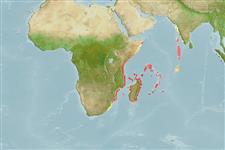Classification / Names
Common names | Synonyms | Catalog of Fishes (gen., sp.) | ITIS | CoL | WoRMS | Cloffa
Actinopterygii (ray-finned fishes) >
Scorpaeniformes (Scorpionfishes and flatheads) >
Platycephalidae (Flatheads)
Etymology: Thysanophrys: Greek, thysanos = tassel + Greek, ophrys = eye brow (Ref. 45335); randalli: Named for John E. Randall.
Environment / Climate / Range
Ecology
Marine; reef-associated; depth range 4 - 28 m (Ref. 92868). Tropical, preferred ?
Western Indian Ocean: Mascarene Islands. Non-type specimens from the Pacific Ocean area are tentatively identified as T. randalli (Line Is., Kiritimati I.; Amer. Samoa; Solomon Is.; Vanuatu; Gilbert Is.).
Size / Weight / Age
Maturity: Lm ? range ? - ? cm
Max length : 9.9 cm SL male/unsexed; (Ref. 92868)
Short description
Morphology | Morphometrics
Dorsal
spines
(total): 9;
Dorsal
soft rays
(total): 11;
Anal
soft rays: 12. This small species has a non-elongated nasal spine base, height of spine about equal to preocular spine height; snout length about 3.2-3.5 times in HL; iris lappet crenate (Ref. 92868).
Life cycle and mating behavior
Maturity | Reproduction | Spawning | Eggs | Fecundity | Larvae
Knapp, L.W., 2013. Descriptions of four new species of Thysanophrys (Scorpaeniformes: Platycephalidae) from the Western Indian Ocean. Zootaxa 3608(2):127-136. (Ref. 92868)
IUCN Red List Status (Ref. 115185)
CITES (Ref. 94142)
Not Evaluated
Threat to humans
Harmless
Human uses
More information
Common namesSynonymsMetabolismPredatorsEcotoxicologyReproductionMaturitySpawningFecundityEggsEgg development
Age/SizeGrowthLength-weightLength-lengthLength-frequenciesMorphometricsMorphologyLarvaeLarval dynamicsRecruitmentAbundance
ReferencesAquacultureAquaculture profileStrainsGeneticsAllele frequenciesHeritabilityDiseasesProcessingMass conversion
Tools
Special reports
Download XML
Internet sources
